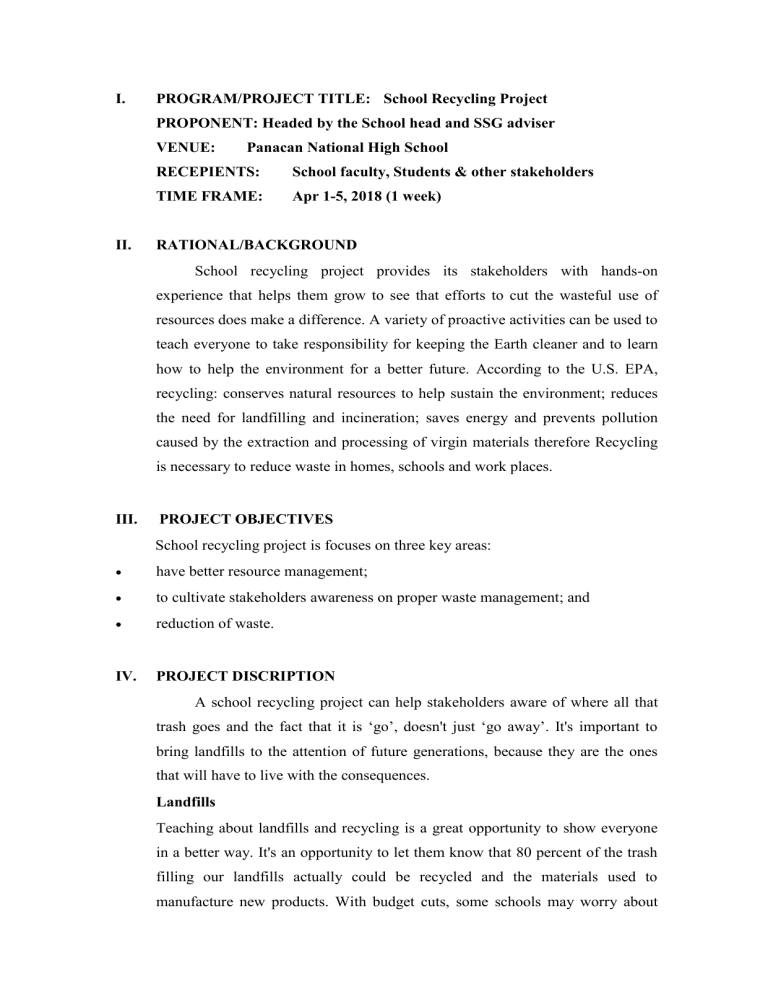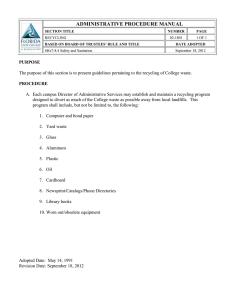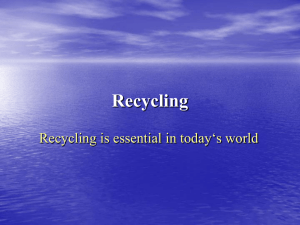
I. PROGRAM/PROJECT TITLE: School Recycling Project PROPONENT: Headed by the School head and SSG adviser VENUE: II. Panacan National High School RECEPIENTS: School faculty, Students & other stakeholders TIME FRAME: Apr 1-5, 2018 (1 week) RATIONAL/BACKGROUND School recycling project provides its stakeholders with hands-on experience that helps them grow to see that efforts to cut the wasteful use of resources does make a difference. A variety of proactive activities can be used to teach everyone to take responsibility for keeping the Earth cleaner and to learn how to help the environment for a better future. According to the U.S. EPA, recycling: conserves natural resources to help sustain the environment; reduces the need for landfilling and incineration; saves energy and prevents pollution caused by the extraction and processing of virgin materials therefore Recycling is necessary to reduce waste in homes, schools and work places. III. PROJECT OBJECTIVES School recycling project is focuses on three key areas: have better resource management; to cultivate stakeholders awareness on proper waste management; and reduction of waste. IV. PROJECT DISCRIPTION A school recycling project can help stakeholders aware of where all that trash goes and the fact that it is ‘go’, doesn't just ‘go away’. It's important to bring landfills to the attention of future generations, because they are the ones that will have to live with the consequences. Landfills Teaching about landfills and recycling is a great opportunity to show everyone in a better way. It's an opportunity to let them know that 80 percent of the trash filling our landfills actually could be recycled and the materials used to manufacture new products. With budget cuts, some schools may worry about implementing another program, but recycling at the school level offers everyone the practical lesson and it can be both affordable and efficient and in some cases even generate funds to help support the project. School Recyclables Among items recycled school items, paper is the most significant cost-saving waste reduction. Just think of how much paper a school uses. As a result, paper makes up 50 to 60 percent of school waste. The advantage to paper is that it can be either reused or recycled. When paper is used on both sides and fully as scratch paper or for making copies, school paper costs drop dramatically. The following classified materials popularly recycled: Scrap Paper: used bond paper, used computer paper, old notebooks, old books, old newspapers, periodicals, other newsprints, cartons and cardboards, colored (assorted) waste paper etc. Glass Bottles: beer, softdrinks, catchup, glass cullets (bubog) etc. Plastics: PET – mineral water bottles, softdrinks, plastic cups, basins, containers, hard plastic, CD cases etc. Metals: tin and aluminum cans, metal frames, stainless etc. Used Oil: used engine oil, used cooking oil Others: tetrapacks. V. OPERATION/IMPLEMENTATION Planning do a survey of how many people are involved (students and employees); check the amount of garbage generated daily and determine a place to store recyclables until they are collected; determine where the recyclable material will be sent: if it will be donated to a cooperative of scavengers, whether it is sold, who will collect and how often. Do not start a selective collection program without knowing where to send the material; do only selective collection of material that can be sent to recycling; develop a communication program of selective collection and community mobilization, that everyone knows how and why to participate. follow up the collection of recyclables, its storing, and its donation; make a periodic review of the school recycling program and disseminate the results to the community; always continue the mobilization program. people involved: teachers, students, secretaries, and cleaners; quality/amount of garbage generated weekly: paper to be discarded from classroom use, teachers’ room use, and offices use; cans, tetrapack, and plastic cups from the school canteen (rinsed and dried); cleaning products packs (rinsed and dried). places to store recyclables: 2 or 3 cardboard boxes (reused from the supermarket) decorated by the children: one in the canteen area, another near the restrooms, and the third one near the school head office. the recyclable material will be sold in any junk shops within the municipality. the communication program of selective collection and school mobilization comprises: posters and leaflets prepared by the children. Implementation find the necessary equipment; train the people involved with the school recycling (cleaning personnel, employees, students, for example); start the communication and mobilization campaign; inaugurate the school recycling program with an event (video presentation, lecture). Hands-on recycling activities VI. SUCCESS INDICATORS VII. KEY PLAYERS School head, teachers, students, other stakeholders Implementing: necessary equipment: 2-3 cardboard boxes (reused from the supermarket). train the people involved with the school recycling: a brief talk with the secretaries and the cleaning personnel; activities to be developed with the students. inaugurate the school recycling program with an event. Keeping the School Recycling ‘Alive’ follow up the collection of recyclables, its storing, and its donation; make a periodic review of the school recycling program and disseminate the results to the school. The results can be disseminated by numbers of cardboard boxes collected every Wednesday. The results will be shown in tables (graphics) in the snack bar area and in the classroom for the students follow the collection up. continuous mobilization program will be done by talking to the people involved from time to time. The students will be stimulated to continue by doing ‘fast’ activities in class (attached). Responsible for the Project: Ana Cláudia Alves. April 2011.




